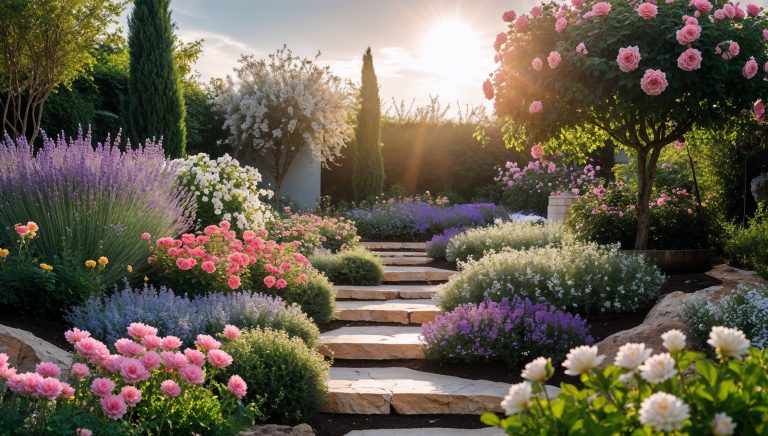A flower garden can add vibrant color, fragrance, and beauty to your outdoor space, whether it’s a small balcony, a backyard, or a larger garden. Creating a flower garden that blooms beautifully throughout the seasons requires planning, understanding the needs of different plants, and providing the right conditions for them to thrive. In this article, we’ll guide you through the steps to create a beautiful flower garden, from choosing the right flowers to designing and maintaining your space.
1. Choosing the Right Flowers
Selecting the right flowers is the first and most important step in creating a beautiful flower garden. You’ll want to choose flowers that suit your climate, soil, and the amount of sunlight available in your garden. Here are a few tips on choosing the right flowers for your space:
- Annuals vs. Perennials: Annuals complete their life cycle in one growing season and need to be replanted each year, while perennials come back year after year. A mix of both can create a garden that has color throughout the growing season. Popular annuals include petunias, marigolds, and impatiens, while perennials like lilies, peonies, and black-eyed Susans can provide long-lasting beauty.
- Flowering Shrubs and Vines: Don’t forget about flowering shrubs and vines, which can add structure and color to your garden. Roses, wisteria, and clematis are beautiful options for adding vertical interest and long-lasting blooms to your garden.
- Sunlight Requirements: Choose flowers that match the sunlight conditions in your garden. For sunny areas, consider flowers like sunflowers, lavender, and salvia. For shaded areas, plants like astilbe, hostas, and begonias thrive in low-light conditions.
- Soil Preferences: Some flowers prefer well-drained, sandy soil, while others do better in rich, loamy soil. Be sure to choose flowers that are suited to the soil conditions in your garden. If your soil is heavy or clay-like, amend it with organic matter to improve drainage.
2. Designing Your Flower Garden
The design of your flower garden plays a significant role in how it will look throughout the seasons. Consider the size and shape of your garden, as well as the types of flowers you want to grow. Here are some design tips to help you create a garden that is visually appealing:
- Layering and Height: Plan your garden with height variation to create depth and interest. Place taller flowers, like sunflowers or delphiniums, in the back or center of the garden, and shorter flowers, like pansies or primroses, in the front. This will allow all of your flowers to be visible and ensure that they aren’t overshadowed by taller plants.
- Color Palette: Choose a color scheme for your flower garden to ensure that the flowers complement each other. You can opt for a monochromatic scheme (different shades of the same color), complementary colors (colors opposite each other on the color wheel, like purple and yellow), or a harmonious scheme (colors next to each other, like blue and green). Mixing different types of flowers and colors creates a dynamic and beautiful garden.
- Flower Groupings: Plant flowers in groups of 3-5 for a more natural and balanced look. Randomly spaced flowers can look haphazard, while groupings give the garden a more organized and cohesive feel. You can also alternate between larger blooms and smaller flowers to add visual interest.
- Paths and Edging: Adding paths or edges to your flower garden creates structure and gives it a more polished look. Stone or gravel paths allow you to walk through the garden without disturbing the plants. Use borders or edging, like low shrubs or small flowers, to define the boundaries of the garden.
3. Planting Your Flowers
Once you’ve chosen your flowers and planned your design, it’s time to plant them. Proper planting techniques are crucial for ensuring your flowers establish strong roots and grow healthy throughout the seasons. Here’s how to plant your flowers correctly:
- Planting Depth: Dig a hole that is slightly larger than the root ball of your flower. Most flowers should be planted at the same depth they were growing in their nursery pots. If you plant them too deep, they may struggle to establish roots, while planting them too shallow can expose the roots to drying out.
- Spacing: Be sure to leave enough space between each plant to allow for proper airflow and growth. Overcrowding your flowers can lead to disease and poor growth. Check the planting instructions for each flower to determine the ideal spacing.
- Watering: After planting, water your flowers thoroughly to help settle the soil around the roots. Be sure to water deeply so the roots have access to moisture. Continue to water your flowers regularly, especially during the establishment phase. If you’re planting during a dry period, make sure to keep the soil consistently moist until the plants are well-established.
4. Caring for Your Flower Garden
Once your flowers are planted, ongoing care is essential for keeping your garden vibrant and healthy. Here are some key care tips:
- Watering: Flowers need consistent moisture to thrive, but they also don’t like to sit in water. Be sure to water your flowers deeply but allow the soil to dry out between waterings. Watering in the early morning or late evening prevents evaporation and ensures the water reaches the roots.
- Fertilizing: Fertilizing your flowers encourages healthy growth and abundant blooms. Use a balanced, slow-release fertilizer to provide essential nutrients. Avoid over-fertilizing, as this can cause plants to become leggy or overly dependent on synthetic nutrients. For flowering plants, consider a fertilizer high in phosphorus to encourage blooming.
- Deadheading: Deadheading is the process of removing spent flowers to encourage new blooms. Regularly remove dead or faded flowers from your plants to keep them looking tidy and to promote the growth of additional blooms.
- Pruning: Some flowers, like roses, benefit from occasional pruning to remove dead or damaged stems and encourage new growth. Pruning also helps maintain the shape of the plant and can improve air circulation, reducing the risk of fungal diseases.
5. Dealing with Pests and Diseases
Even the healthiest flower gardens can be susceptible to pests and diseases. Early detection and proper management can help keep your garden flourishing without harm.
- Common Pests: Keep an eye out for common pests like aphids, spider mites, and slugs. To control pests, consider using natural methods like neem oil, insecticidal soap, or introducing beneficial insects like ladybugs. For severe infestations, you may need to use a chemical pesticide, but always follow the instructions carefully.
- Preventing Diseases: Ensure your flowers are planted in well-drained soil to prevent root rot. Overcrowding and poor air circulation can lead to fungal diseases like powdery mildew or black spot. Remove infected plants and avoid watering overhead to keep foliage dry.
- Mulching: Apply a layer of mulch around your flowers to retain moisture, suppress weeds, and prevent soil diseases. Organic mulches like wood chips or shredded leaves decompose over time, enriching the soil with nutrients.
6. Seasonal Care
Flower gardens require some seasonal maintenance to ensure they continue to thrive through different weather conditions.
- Spring and Summer: During the growing season, keep your flowers well-watered, deadhead regularly, and add fertilizer to encourage vibrant blooms. Check for pests and diseases frequently to address issues early.
- Fall: In the fall, prepare your flower garden for the cooler months by cutting back dead or damaged stems and removing any fallen leaves. If you live in a colder climate, consider mulching your plants to protect them from winter frost.
- Winter: Many flowers go dormant in the winter, and some may need to be covered or moved indoors to protect them from freezing temperatures. Be sure to protect any tender plants and plan for the spring season by preparing your garden beds.
Conclusion
Creating a beautiful flower garden is a rewarding experience that adds color, fragrance, and life to your outdoor space. By selecting the right flowers for your garden, planning your design, and providing the proper care, you can enjoy a garden that blooms beautifully year after year. With a little attention to detail, you’ll be able to create a stunning flower garden that will become a highlight of your home.

